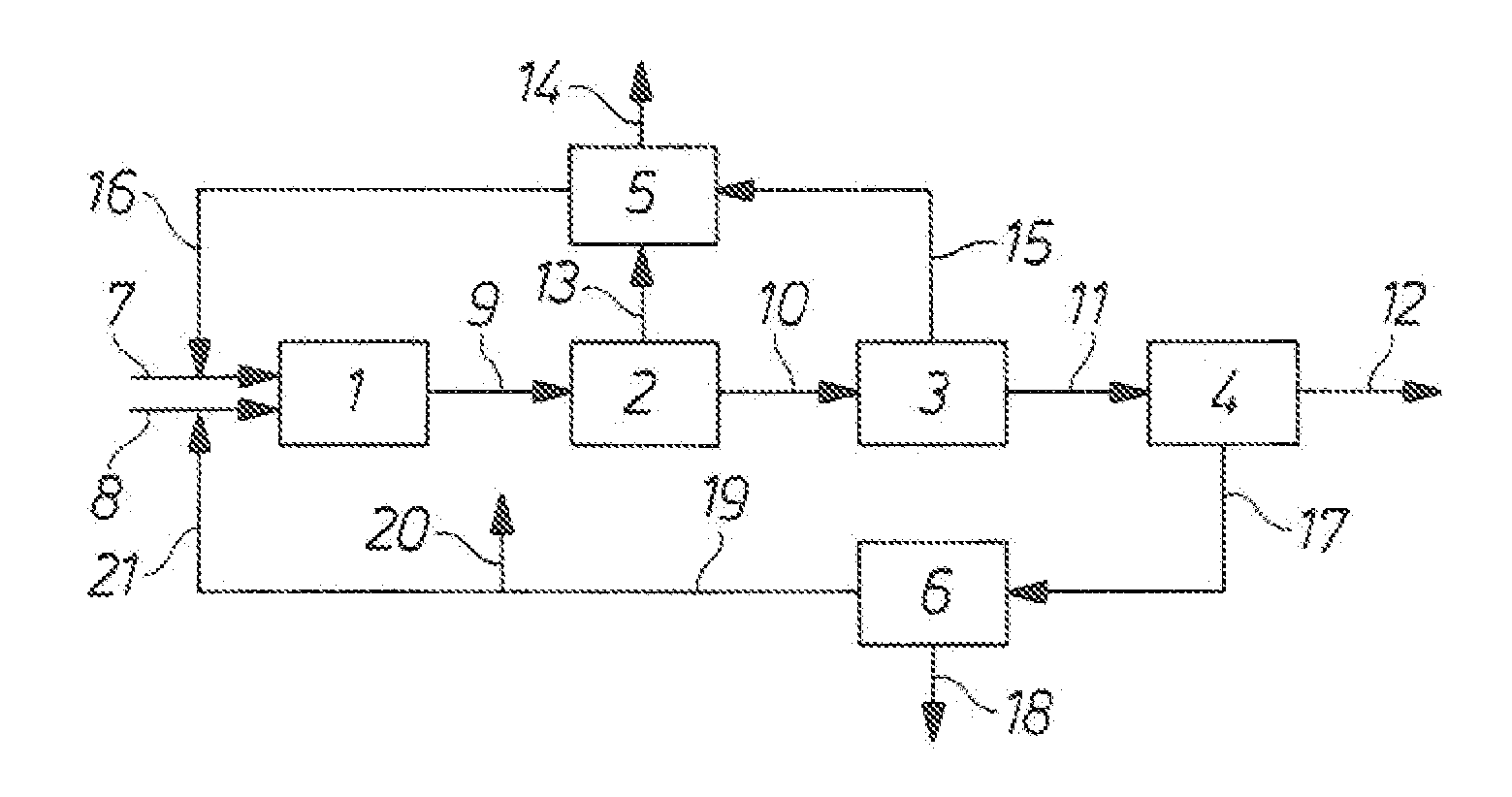Process for the production of isocyanates
a technology of isocyanate and process, which is applied in the preparation of isocyanic acid derivatives, organic compound preparation, chemistry apparatus and processes, etc., can solve the problems of reducing yield and affecting quality, and achieve the goal of minimizing yield loss and quality impairment of isocyanate produced
- Summary
- Abstract
- Description
- Claims
- Application Information
AI Technical Summary
Benefits of technology
Problems solved by technology
Method used
Image
Examples
example 1
Production of a Mixture of Diamines and Polyamines
[0034]In a stirred vessel, 2600 g aniline were thoroughly mixed with 1000 g formalin (30 wt. % aqueous solution of formaldehyde, based on the weight of the solution) at 25° C., with stirring, during which the mixture heated up to 60° C. The stirrer was turned off and the aqueous phase settling out at the top was separated off 68 g of 30 wt. % aqueous hydrochloric acid, were then mixed in, while stirring again and cooling, maintaining a temperature of 45° C. After continuing to stir at this temperature for 15 min, the cooling was replaced by heating and the mixture was uniformly heated to 140° C. in the course of 120 min under a pressure of 5 bar, and was then kept at this temperature for 15 min.
[0035]The mixture was then cooled to 100° C., depressurized to normal pressure and neutralized by adding 54 g of 50 wt. % aqueous sodium hydroxide solution while stirring. After turning off the stirrer, the phases were allowed to settle and th...
example 2
Production of a Mixture of Diisocyanates and Polyisocyanates Using Contaminated Solvent (Not According to the Invention)
[0041]In a stirred reactor, 1900 g of the mixture of diamines and polyamines obtained in Example 1 were dissolved in 5700 g chlorobenzene with a content of 200 ppm phosgene and 200 ppm MDI, based in each case on the weight of the solvent chlorobenzene. In a second vessel made of stainless steel (DIN 1.4571), a 33 wt. % (based on the weight of the solution) phosgene solution was prepared by dissolving 3800 g phosgene in 7600 g chlorobenzene while cooling to 0° C., and the amine and phosgene solutions were mixed while stirring intensively. The resulting suspension of solids was then heated slowly with the formation of hydrogen chloride gas, which was withdrawn by suitable means. During this process, a homogeneous solution of the polyisocyanate was formed. The solvent was now separated off by distillation, as a result of which 2370 g of a mixture of diisocyanates and ...
example 3
Production of a Mixture of Diisocyanates and Polyisocyanates Using Pure Solvent (According to the Invention)
[0049]In a stirred reactor, 1900 g of the mixture of diamines and polyamines obtained in Example 1 were dissolved in 5700 g chlorobenzene with a content of 20 ppm phosgene and 20 ppm MDI, based in each case on the weight of the solvent chlorobenzene. In a second vessel made of stainless steel (DIN 1.4571), a 33 wt. % (based on the weight of the solution) phosgene solution was prepared by dissolving 3800 g phosgene in 7600 g chlorobenzene while cooling to 0° C., and the amine and phosgene solutions were mixed into this while stirring intensively. The resulting suspension of solids was then heated slowly with the formation of hydrogen chloride gas, which was withdrawn by suitable means. During this process, a homogeneous solution of the polyisocyanate was formed. The solvent was then separated off by distillation, as a result of which 2370 g of a mixture of diisocyanates and pol...
PUM
| Property | Measurement | Unit |
|---|---|---|
| weight ratio | aaaaa | aaaaa |
| weight ratio | aaaaa | aaaaa |
| temperature | aaaaa | aaaaa |
Abstract
Description
Claims
Application Information
 Login to View More
Login to View More - R&D
- Intellectual Property
- Life Sciences
- Materials
- Tech Scout
- Unparalleled Data Quality
- Higher Quality Content
- 60% Fewer Hallucinations
Browse by: Latest US Patents, China's latest patents, Technical Efficacy Thesaurus, Application Domain, Technology Topic, Popular Technical Reports.
© 2025 PatSnap. All rights reserved.Legal|Privacy policy|Modern Slavery Act Transparency Statement|Sitemap|About US| Contact US: help@patsnap.com


